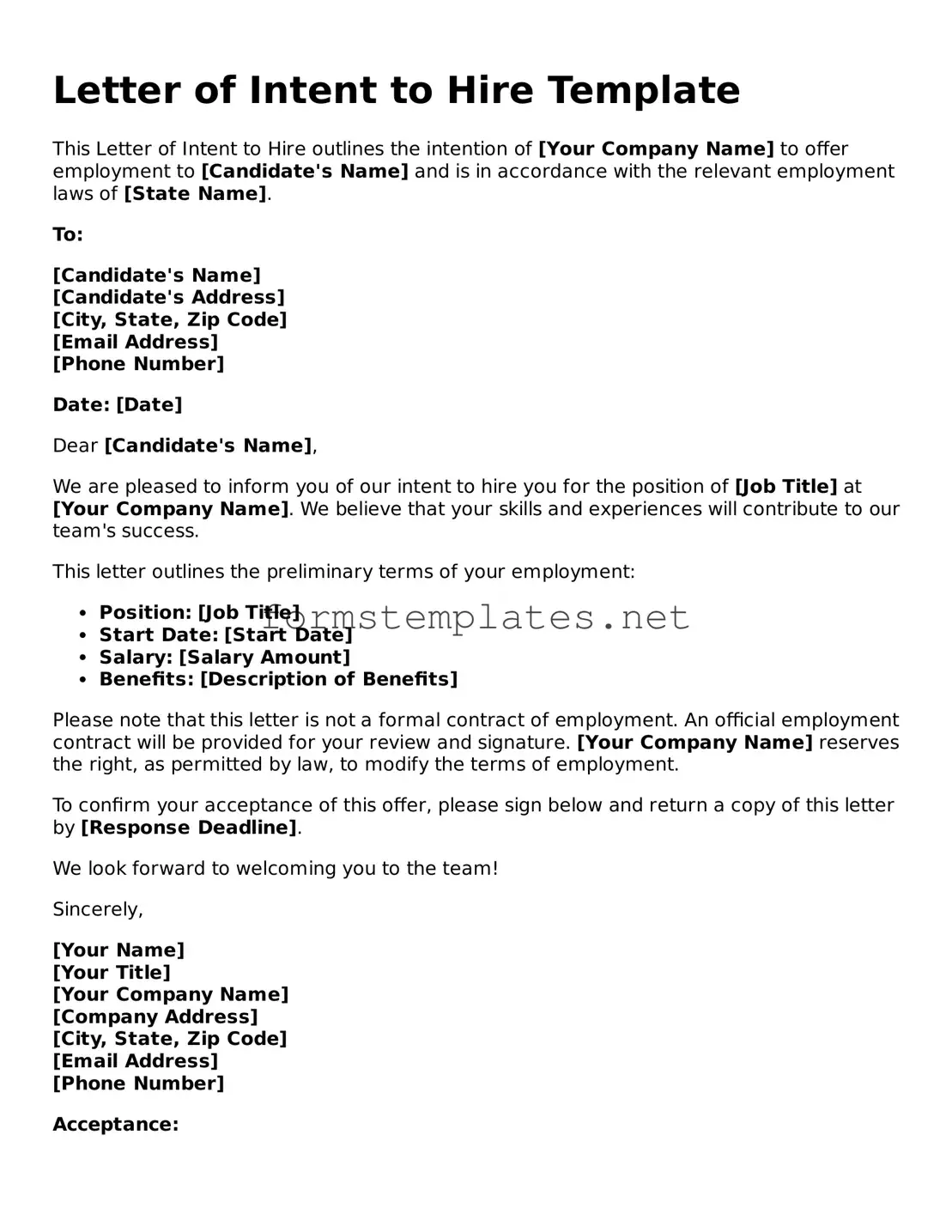What is a Letter of Intent to Hire?
A Letter of Intent to Hire is a document that expresses a preliminary agreement between an employer and a potential employee. It outlines the intention of the employer to hire the individual for a specific position, often detailing key terms such as job title, salary, and start date. While it is not a legally binding contract, it serves as a formal indication of the employer's commitment to bringing the candidate on board.
Is a Letter of Intent to Hire legally binding?
Generally, a Letter of Intent to Hire is not considered legally binding. It functions more as a goodwill gesture rather than a contractual obligation. However, certain elements within the letter may be enforceable if they are explicitly stated and agreed upon by both parties. It is crucial for both the employer and the prospective employee to understand that this document does not guarantee employment until a formal contract is signed.
What should be included in a Letter of Intent to Hire?
Typically, a Letter of Intent to Hire should include the following elements:
-
The job title and description
-
The proposed start date
-
The salary and any bonuses or benefits
-
Conditions of employment, such as background checks or drug tests
-
A statement indicating that the letter is not a binding contract
Including these components helps clarify expectations for both parties and sets the stage for a successful employment relationship.
How is a Letter of Intent to Hire different from a job offer?
A Letter of Intent to Hire is often seen as a precursor to a formal job offer. While a job offer typically includes specific terms and conditions of employment and is intended to be accepted or rejected, the Letter of Intent to Hire serves as an initial expression of interest. It may outline the intent to hire but does not finalize the employment terms. Once both parties agree on the details, a formal job offer can follow.
When should a Letter of Intent to Hire be used?
This document is most useful in situations where an employer wants to communicate their interest in hiring a candidate before finalizing the details. It can be particularly beneficial in competitive job markets, where candidates may be considering multiple offers. By sending a Letter of Intent to Hire, an employer can express their commitment and encourage the candidate to move forward in the hiring process.
Can a candidate negotiate terms after receiving a Letter of Intent to Hire?
Yes, a candidate can certainly negotiate terms after receiving a Letter of Intent to Hire. This document does not lock either party into an agreement; rather, it opens the door for discussions. Candidates should feel empowered to express their needs and preferences regarding salary, benefits, or job responsibilities. Open communication can lead to a mutually beneficial agreement.
How does a Letter of Intent to Hire affect the hiring timeline?
The issuance of a Letter of Intent to Hire can expedite the hiring timeline. It signals to the candidate that the employer is serious about moving forward, which may prompt a quicker response. However, it is essential to remember that the timeline may still depend on various factors, such as the completion of background checks or other pre-employment requirements.
What should a candidate do upon receiving a Letter of Intent to Hire?
Upon receiving a Letter of Intent to Hire, a candidate should carefully review the document. They should consider the terms outlined and determine if they align with their career goals and expectations. If everything appears satisfactory, the candidate may wish to confirm their interest and discuss any potential negotiations. If there are concerns or questions, it is advisable to address them directly with the employer before moving forward.
Can a Letter of Intent to Hire be rescinded?
Yes, a Letter of Intent to Hire can be rescinded by the employer. Since it is not a legally binding contract, the employer retains the right to withdraw their intent at any point prior to the signing of a formal employment contract. This situation may arise due to unforeseen circumstances, budget changes, or the discovery of new information regarding the candidate. Candidates should remain aware of this possibility as they navigate the hiring process.
